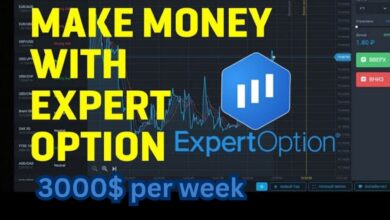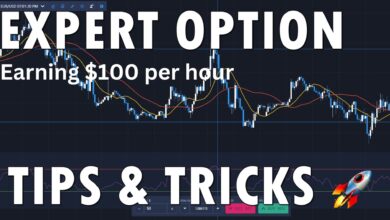How to Earn $5,000 per Month from Forex Trading.

Forex trading, or the exchange of currencies on the global market, can be a profitable venture for those who master the craft. Earning $5,000 per month from Forex is an achievable goal, but it requires the right strategy, discipline, risk management, and a solid understanding of market dynamics. Let’s explore a practical approach for anyone interested in making $5,000 per month from Forex trading.
1. Understanding Forex Basics
Forex (foreign exchange) is a global decentralized market for trading currencies. The goal is to exchange one currency for another at a favorable rate and profit from price movements. The key elements you must understand are:
Currency Pairs: Forex is traded in pairs like EUR/USD, GBP/JPY. Each pair has a base and a quote currency.
Pips: A pip is the smallest price movement in a currency pair. It’s crucial to understand how pips work because your profits and losses are calculated in pips.
Leverage: Forex brokers offer leverage to increase your buying power. While this can multiply your profits, it also amplifies your risks.
2. Setting Realistic Expectations
Before diving in, it’s important to set realistic goals. Earning $5,000 per month isn’t impossible, but it requires a solid foundation. Depending on your starting capital and the amount of risk you’re willing to take, the road to $5,000 may take time.
Example: If your goal is to make $5,000 and you plan to risk 2% per trade, and you target an average return of 5% per month, you’ll need a capital of around $100,000. However, starting smaller with a lower monthly goal can still lead to meaningful progress over time.
3. Choosing the Right Broker
Your broker plays a vital role in your Forex journey. Choose a regulated broker with a reliable trading platform, tight spreads, and good execution speed. Consider factors such as:
Leverage Options: Choose a leverage ratio that aligns with your risk tolerance (e.g., 1:30 or 1:50).
Spreads: Lower spreads mean lower trading costs, which can help maximize your returns.
Trading Platform: Use user-friendly platforms like MetaTrader 4 (MT4) or MetaTrader 5 (MT5), which offer advanced charting tools and automated trading features.
4. Creating a Trading Plan
A detailed trading plan is essential for success. This plan should include:
Trading Strategy: Determine what kind of trader you are—day trader, swing trader, or position trader. Each style requires a different approach.
Day Trading: Short-term trades where positions are opened and closed within the same day.
Swing Trading: Holding positions for days or weeks, targeting larger price moves.
Position Trading: Long-term trades that last for weeks, months, or even years.
Risk Management: Always use a stop-loss to limit potential losses. A general rule is to risk no more than 1-2% of your trading capital on any single trade. This ensures that you can survive a series of losing trades without depleting your account.
Profit Targets: Set realistic profit targets for each trade. For example, a risk-reward ratio of 1:2 means that for every $100 you risk, you aim to make $200.
5. Risk Management and Psychology
Risk management is one of the most critical aspects of trading, and ignoring it is one of the main reasons traders fail. You should:
Use Proper Position Sizing: Calculate the position size for each trade based on your risk tolerance. For example, if you have $10,000 and you’re risking 2% per trade, you should risk $200 per trade.
Avoid Overleveraging: Leverage can amplify both profits and losses. Use leverage wisely to avoid magnifying your risk unnecessarily.
Stay Disciplined: Emotional trading leads to mistakes. Stick to your plan and avoid chasing losses.
6. Education and Analysis
To consistently make money in Forex, you need a strong foundation in both technical and fundamental analysis:
Technical Analysis: This involves reading price charts and using technical indicators (moving averages, RSI, MACD) to predict future price movements.
Fundamental Analysis: This involves analyzing macroeconomic factors (interest rates, GDP growth, inflation) that affect currency prices.
Regularly educate yourself by following market news, studying economic reports, and analyzing the impact of central bank policies on currency movements.
7. Consistency is Key
The most successful traders are consistent. They don’t aim for huge wins on every trade; instead, they focus on small, consistent gains. If you can make a steady 1-2% profit per week, you’ll be on your way to earning $5,000 per month.
For example, if you have $50,000 in your trading account and make a consistent 10% return each month, you’ll earn $5,000 per month. Smaller accounts can achieve similar results by compounding their profits over time.
8. Automated Trading (Optional)
Once you have a profitable strategy, consider automating it through the use of trading algorithms or Expert Advisors (EAs). This can help remove emotional decision-making and allow you to execute trades 24/7, even when you’re not actively monitoring the markets.
9. Keeping Track of Progress
Keeping a trading journal is crucial to your success. Document every trade, including the reasons for entering and exiting, the outcome, and the lessons learned. Regularly review your journal to identify patterns and areas for improvement.
10. Staying Updated with Market Trends
Forex is a dynamic market, and staying updated with the latest news, economic reports, and geopolitical events is essential. Markets react to announcements such as interest rate changes, unemployment reports, and political instability. Use an economic calendar to stay ahead of key events that could impact your trades.
Conclusion
Earning $5,000 per month from Forex trading is not a quick or easy process, but with discipline, a sound trading plan, proper risk management, and ongoing education, it is achievable. Start small, focus on consistency, and reinvest your profits to grow your account over time. Remember, patience and persistence are crucial traits for any successful trader.
Ultimately, Forex trading offers flexibility and financial independence, but it requires a serious commitment to mastering the market and managing risks effectively.



